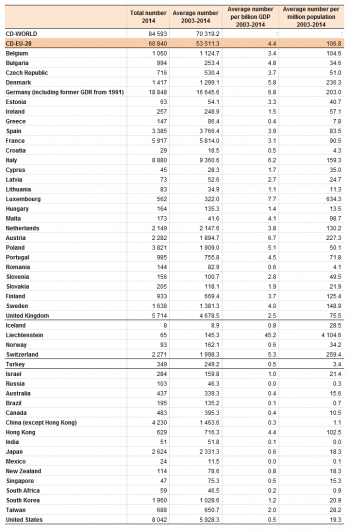Archive:Intellectual property rights statistics
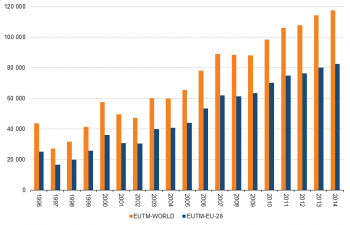
Source: Eurostat (ipr_ta_tot)
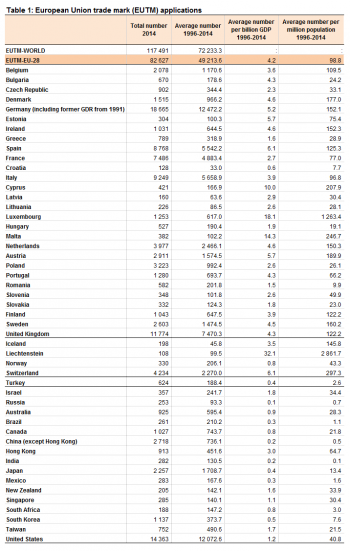
Source: Eurostat (ipr_ta_tot) (ipr_ta_gdp) (ipr_ta_pop)

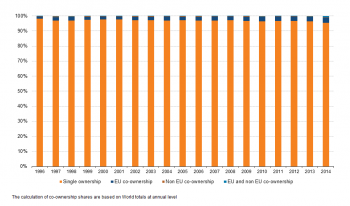
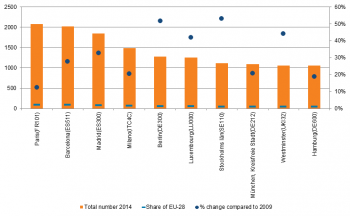




- Data extracted in October 2015. Most recent data: Further Eurostat information, Main tables and Database
This article presents statistics on two types of intellectual property rights (IPR), namely Community trademarks (CTMs) and design applications (CDs) in the European Union (EU). The statistics were published by Eurostat and are based on raw data received from the Office for Harmonization in the Internal Market (OHIM), the EU’s agency responsible for registering community trademarks and designs.
Intellectual property broadly includes everything created by the human mind. Common types of intellectual property rights include patents, trademarks, industrial designs and copyrights. They constitute means by which creators seek protection for their intellectual property. Trademarks and designs reflect non-technological innovation in every sector of economic life, including services. In this context, indicators based on trademark and design data can provide a link between non-technological innovation and the market. R&D and patents are mainly related to the measurement of technological innovation and scientific expertise.
Main statistical findings
Community trademark applications
In 2013, OHIM received more than 80 000 CTM applications for trademark protection from EU-28 Member States. In 2009-13, the total number of CTM applications increased both in the EU-28 and worldwide (see Figure 1), after a small decrease between 2007 and 2008.
In 2013, Germany and the United Kingdom had the highest number of CTM applications out of all the EU-28 Member States (see Table 1). The number of CTM applications from these two countries accounted for almost 40 % of total applications received by OHIM from EU-28 Member States in 2013. Based on the number of trademark applications made in 1996-2013, the leading European countries in terms of CTM protection are Germany, the United Kingdom, Italy, Spain, France, the Netherlands and Switzerland. The highest number of CTM applications made to OHIM from outside Europe came from the United States and Japan . In 1996-2013, the United States had the highest average number of CTM applications out of all non-European countries (11 950). In 2013, OHIM received 14 849 applications from the United States for trademark protection in the EU.
The use of relative terms makes it possible to compare CMT application figures expressed as a percentage of gross domestic product (GDP) and of population size (see Table 1). Figures expressed as a percentage of GDP or population size lead to different conclusions than those based only on total numbers. The relative figures for 1996-2013 were calculated as the ratios of the average number of CTM applications in relation to the average GDP or average population size. Figures per GDP show that countries with small economies in terms of absolute GDP values, like Liechtenstein (LI), Luxembourg (LU), Malta (MT) and Cyprus (CY), have the highest numbers of applications for protecting community trademarks when CTM applications per GDP are taken into account. According to the relative figures, Liechtenstein, Luxembourg, Switzerland and Cyprus have the highest number of CTM applications per million inhabitants.
These high figures in certain countries were the reason for further investigation into IPR protection in the EU. The subsequent analysis showed that certain countries provide an attractive corporate taxation environment for protecting intellectual property. It also showed that the tax systems of countries like Cyprus, Malta, Liechtenstein and Luxembourg are beneficial for IPR protection. The review of available literature verifies the fact that corporations benefit from the fiscal policies of certain countries with low corporate tax rates, including from tax exceptions for IPR protection. It is possible to benefit from the tax policies of foreign countries because intellectual property does not have a clear geographical location.
An extensive analysis of the role of tax systems in the protection of intellectual property rights for corporations is available in the paper entitled “Community Trade mark & Design Applications, High figures for particular countries per GDP and Population - The role of provided motivations on IPR protection”.
The number of CTM applications that OHIM received from within the EU increased by 5 % between 2012 and 2013, for 39 out of 49 countries (80 % of countries). Thirteen countries increased their total number of CTM applications by over 20 % in 2013. They include eight EU-28 Member States, one EU-28 candidate country and four non EU-28 countries. The countries with the highest annual growth rate in CTM applications between 2012 and 2013 are: Iceland (232 %), Croatia (198 %), Greece (58 %), Malta (37 %), Slovenia (29 %), Poland (28 %), Hungary (27 %), Ireland (27 %), and Lithuania (23 %) (see Figure 2). The countries with the most significant decrease in the total number of CTM applications made to OHIM between 2012 and 2013 are Russia (12 %), India (14 %) and Romania (20 %).
An analysis of co-ownership in Community trademark applications shows that more than 96 % of CTM applications annually received by OHIM belong to a single owner (see Figure 3). Cooperation between EU owners is very limited and, on average, accounts for 2.5 % of CTM applications received by OHIM between 1996 and 2013.
Community design (CD) filed in applications
In 2013, the total number of designs (see definition under "Context") filed in design applications by EU-28 applicants was equal to 60 541. It had increased steadily over 2003-07 both in the EU-28 and worldwide (see Figure 4), and in 2008 decreased slightly compared with 2007. In 2009, the total number of designs at EU-28 and worldwide level was decreased further both in the EU-28 and worldwide, but started to increase again in 2010. In 2013, the total number of Community designs worldwide reached its highest level since 2003. In the EU-28, design protection was strengthened from 2009 onwards, more so than at worldwide level, with Design protection reaching and overtaking during 2013 the levels of 2007.
In 2013, Germany had the highest number of designs in the EU-28 (18 260; see Table 2), followed by Italy (8 563). The total number of designs originating from these two countries accounts for 44 % of total designs received by OHIM in 2013 from EU-28 Member States. The following countries had the highest average number of design protection in the EU in 2003-13: Germany (16 458), Italy (9 419), France (5 858), the United Kingdom (4 590) and Spain (3 801). The United States (7 573), China (excl. Hong Kong) (4 008) and Japan (2 564) had the highest average numbers of Community designs from outside the EU in 2013. Of these, the United States had the highest number, almost 5 739 in 2003-13.
Figures on community designs can also be expressed as a percentage of gross domestic product (GDP) and of population size (see Table 2). As was the case for CTM applications, these figures lead to different conclusions than those calculated only based on totals. For 2003-13, the relative figures were calculated as the ratio of the average number of designs to the average GDP or population size. When we look at design protection in Europe in relation to the size of the economy, the conclusions are similar to those drawn for trademarks. Lichtenstein has the highest ratio of designs per billion GDP out of all of 49 countries (28-EU Member States, 4- European Free Trade Association (EFTA) Member States, 1 candidate country for EU membership and 16 non-EU countries) . However, the countries with the highest number of design protection per billion GDP are different from those for CTM applications, with the exception of Luxembourg. The others are Austria, Italy and Denmark. These countries’ performance is also best when the total number of designs is expressed per million inhabitants.
In the EU, the number of designs received by OHIM increased by 2 % between 2012 and 2013 (see Figure 5). The increase was even higher for designs filed in applications from the rest of the world, at 6 % for this period. Between 2012 and 2013, the number of Community designs increased for 28 out of 49 countries (almost 60 % of all countries).
For five countries, of which four are European, the total number of designs submitted in 2013 increased by over 100 % when compared with 2012. These very high annual growth rates were seen in countries with a small number of design filed in applications. The following countries had the highest annual growth rates in the number of Community designs: Malta (832 %), Singapore (177 %), Bulgaria (165 %), Greece (162 %) and Liechtenstein (134 %). The United Kingdom is one of the European countries with the highest number of designs on which protection is requested, with its total number of designs filed in applications with OHIM having increased by 14 % in 2013 compared to 2012. Similarly, France saw a 7 % increase. For Italy and Germany, the total number of Community designs decreased by 3 % and 2 % respectively in 2013 compared with 2012. In the EU-28, the most significant decrease in the total number of Community design filed in applications between 2012 and 2013 was seen in Portugal (20 %), Latvia (23 %) and the Czech Republic (34 %).
An analysis of community design co-ownership shows that almost 80 % of designs for which an application was filed with OHIM belong to a single owner (see Figure 6). Between 2003 and 2013, there were more jointly owned Community designs (17%) than Community trademarks (2.5%) in the EU. EU co-ownership remained stable in 2011-13, with almost 15 % of Community designs belonging to owners originating from EU Member States.
Data sources and availability
The statistical indicators on Community trademarks and designs are produced based on raw data provided by the Office for Harmonization in the Internal Market (OHIM). OHIM is the EU’s agency responsible for registering Community trademarks and designs. Community trademarks and designs provide protection throughout the European Union.
Context
Trademark and design statistics can serve as tools for illustrating the achievements reached by the European Union in its strategies for developing a smarter, knowledge-based, greener economy, growing fast and sustainably, and creating high levels of employment and social progress (under the Lisbon Strategy and the EU 2020 Strategy).
The compilation of statistics on trademarks and designs enables the European Commission to better measure non-technological innovation, whose importance is increasing for economies that are heavily reliant on the service sector. Trademarks and industrial designs give protection across all sectors of the economy and make it possible to better measure an innovation’s commercial value. Patent and R&D statistics mainly reflect inventions and are less related to product commercialization, as patent and R&D activity does not always lead to a technically successful solution that can be used in a commercial product or service.
Eurostat has added organisational and marketing innovation to its guidelines for collecting and interpreting innovation data (‘Oslo Manual’) and has incorporated related questions into the Community Innovation Survey (CIS 4 and CIS 2012). Non-technological innovations are mostly product innovations that take place in sectors with a relatively low technological content, notably the service sector.
Trademarks are words or figurative marks that are an essential part of the ‘identity’ of goods and services. They help deliver brand recognition, for example in logos, and play an important role in marketing and communication. It is possible to register a variety of trademarks, including words, graphical representations, and even sounds. Trademark owners have a choice of obtaining protection on a country-by-country basis, or internationally.
A registered Community trademark (CTM) is an exclusive right that protects distinctive signs. It is registered directly with OHIM in Alicante in accordance with the conditions specified in the CTM Regulations, and is valid across the EU. A CTM registration lasts for 10 years but can be renewed indefinitely (Source: OHIM).
A design is the outward appearance of a product or part of it, resulting from the lines, contours, colors, shape, texture, materials and/or its ornamentation. The design or shape of a product can be synonymous with a company’s branding and image and can become an asset with monetary value that could increase.
A registered Community design (CD) is an exclusive right that covers the outward appearance of a product or part of it. It is valid in all countries of the European Union. It has an initial duration of five years from the filing date and can be renewed in blocks of five years up to a maximum of 25 years. Applicants may market a design for up to 12 months before filing for a registered community design without destroying its novelty (Source: OHIM).
See also
- Innovation and information society statistics introduced
- Innovation statistics
- Patent statistics background
Further Eurostat information
Publications
- Science, technology and innovation in Europe - Pocketbook, 2013 edition
- Science, technology and innovation in Europe - Pocketbook, 2012 edition
Database
- Science and technology, see:
- Intellectual property rights (ipr)
- Community trade marks (CTM) (ipr_t)
- Community trade mark (CTM) applications by receive year (ipr_ta)
- Community trade mark (CTM) publications by publication year (ipr_tp)
- Community trade mark (CTM) registrations by registration year (ipr_tr)
- Community trade mark (CTM) renewals by receive year (ipr_trn)
- Community trade mark (CTM) lifecycle by receive year (ipr_tl)
- Cooperation for Community trade marks by receive year (ipr_tc)
- Community trade marks (CTM) (ipr_t)
- Community trade marks (CTM) (ipr_t)
- Applications filled for the registration of one or more Community designs (CD) by receive year (ipr_da)
- Community design (CD) filed in applications by receive year (ipr_dfa)
- Registered Community designs (RCD) by registration year (ipr_dr)
- Registered Community design (RCD) publications by publication year (ipr_dp)
- Registered Community designs (RCD) renewals by renewal year (ipr_drn)
- Cooperation for Community designs (CD) by receive year (ipr_dc)
- Community trade marks (CTM) (ipr_t)
Dedicated section
Methodology / Metadata
- Intellectual property rights (ipr) (ESMS metadata file — ipr_esms)
